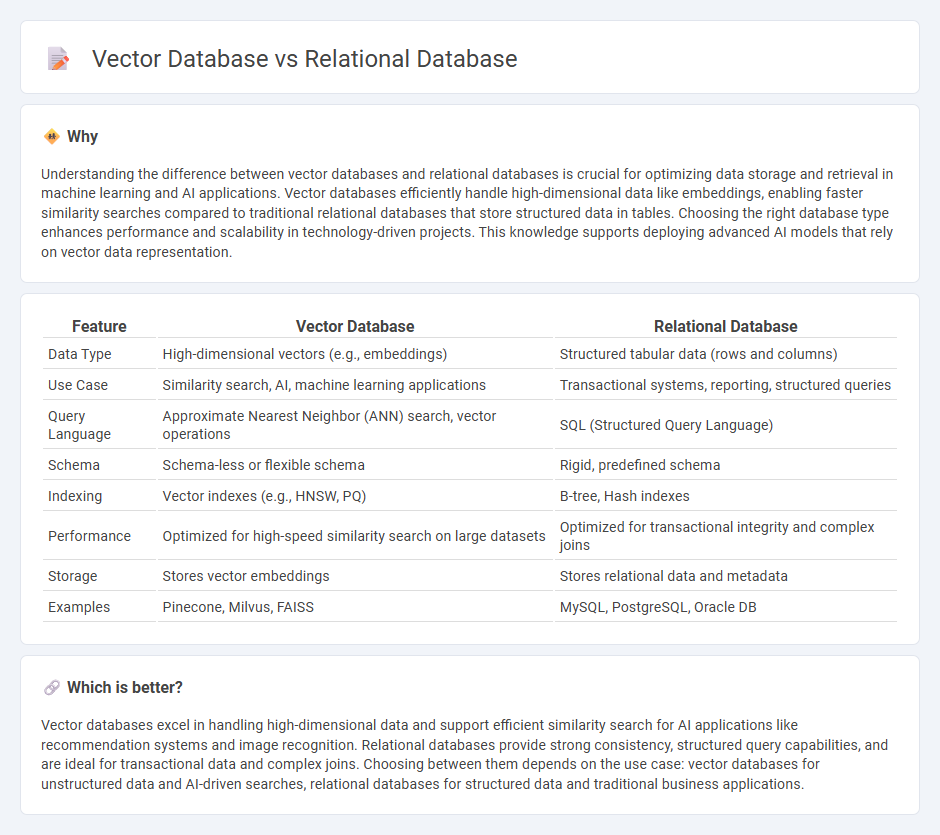
Vector databases efficiently store and query high-dimensional data, making them ideal for AI applications like image recognition and natural language processing. Relational databases organize data into structured tables with predefined schemas, excelling in transactional systems and complex queries involving relationships. Explore the differences further to understand which technology suits your data needs best.
Why it is important
Understanding the difference between vector databases and relational databases is crucial for optimizing data storage and retrieval in machine learning and AI applications. Vector databases efficiently handle high-dimensional data like embeddings, enabling faster similarity searches compared to traditional relational databases that store structured data in tables. Choosing the right database type enhances performance and scalability in technology-driven projects. This knowledge supports deploying advanced AI models that rely on vector data representation.
Comparison Table
| Feature | Vector Database | Relational Database |
|---|---|---|
| Data Type | High-dimensional vectors (e.g., embeddings) | Structured tabular data (rows and columns) |
| Use Case | Similarity search, AI, machine learning applications | Transactional systems, reporting, structured queries |
| Query Language | Approximate Nearest Neighbor (ANN) search, vector operations | SQL (Structured Query Language) |
| Schema | Schema-less or flexible schema | Rigid, predefined schema |
| Indexing | Vector indexes (e.g., HNSW, PQ) | B-tree, Hash indexes |
| Performance | Optimized for high-speed similarity search on large datasets | Optimized for transactional integrity and complex joins |
| Storage | Stores vector embeddings | Stores relational data and metadata |
| Examples | Pinecone, Milvus, FAISS | MySQL, PostgreSQL, Oracle DB |
Which is better?
Vector databases excel in handling high-dimensional data and support efficient similarity search for AI applications like recommendation systems and image recognition. Relational databases provide strong consistency, structured query capabilities, and are ideal for transactional data and complex joins. Choosing between them depends on the use case: vector databases for unstructured data and AI-driven searches, relational databases for structured data and traditional business applications.
Connection
Vector databases and relational databases intersect in managing and querying structured and unstructured data for advanced AI applications. Relational databases store data in tables with predefined schemas, ideal for structured data, while vector databases handle high-dimensional vectors generated by machine learning models to enable similarity search. Integrating vector search capabilities into relational databases enhances complex data retrieval efficiency and supports AI-driven functionalities like recommendation systems and natural language processing.
Key Terms
Schema
Relational databases use a fixed schema with tables, rows, and columns to organize structured data, ensuring data integrity and strong consistency through predefined relationships. Vector databases store unstructured or semi-structured data as high-dimensional vectors without requiring a rigid schema, enabling efficient similarity searches and machine learning applications. Explore the differences in schema design to determine which database type best suits your data needs.
Embeddings
Relational databases organize data into structured tables using predefined schemas, excelling in transactional operations but often struggling with high-dimensional data like embeddings. Vector databases specialize in efficiently storing and querying embeddings by leveraging similarity search algorithms, enabling fast retrieval of semantically related information across massive datasets. Explore more about how embedding-aware vector databases transform AI-driven applications and improve search accuracy.
Query Language
Relational databases use Structured Query Language (SQL) to efficiently perform precise searches, manage structured data, and execute complex joins across multiple tables. Vector databases employ specialized query languages or APIs designed to handle high-dimensional vector data, enabling similarity searches and nearest neighbor retrieval using mathematical distance metrics like cosine similarity or Euclidean distance. Explore further to understand how query languages influence performance and use cases in relational versus vector database systems.
Source and External Links
What is a Relational Database? - Amazon Web Services (AWS) - A relational database organizes data into tables with rows and columns where relationships between data points are predefined, allowing flexible querying by joining tables to reveal insights across data sets.
What Is a Relational Database? (RDBMS)? - Oracle - A relational database stores related data in tables using unique keys, enabling data from different tables to be connected and efficiently accessed, such as linking customer information to orders via a customer ID.
What Is A Relational Database (RDBMS)? | Google Cloud - A relational database structures data in tables with predefined relationships, allowing logical connections between tables through common attributes, facilitating complex queries and insights without reorganizing data.
 dowidth.com
dowidth.com